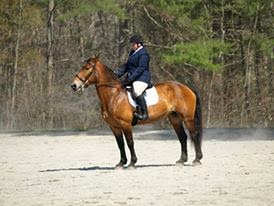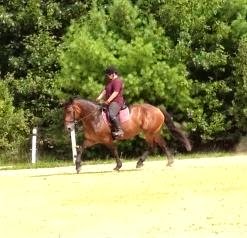Search the Site
Kirsten's Blog Post # 5
When you are riding or working with horses, when you come up against a road block, do you keep drilling the problem? Never changing how you are asking? Never assessing the situation?
For instance, if your horse has problems picking up the canter/correct lead, do you just sit up there running him off his feet until it finally "magically" happens? If so, why? What are you teaching him? Do you think he is connecting the correct canter aids you gave 3 minutes ago to the act of a smooth correct canter transition onto the correct lead when he finally falls into the canter? All you are doing is running him faster and faster until he is past his balance and cantering is physically easier and who the heck knows what lead you are going to end up with.
Similarly, if your horse is afraid of a large ditch, galloping said horse and said ditch time... after time.... after time... after time.... AFTER TIME accomplishes nothing except getting stop.... after stop.... after stop.... after stop.
"Insanity: Doing the same thing thing over and over again and expecting different results"
- Albert Einstein
That kind of Insanity does not impress Ariat
So why do so many horseback riders do this? They are not creative riders! Another way to think about it is how many "tools" do you have in your "tool box"?
This blog topic actually came to me tonight while going to battle with dressaging Ariat. Dressaging Ariat is such an experience I even invented a new term to describe her:Girrafferator. *Most* of the time when Ariat is being "naughty" in the dressage ring it is not actually her being naughty, it is her telling me she is too tight and stiff to come over her back and bend just yet. About this time last year our dressage was pretty horrible and things were just not working. She was extremely heavy, unbalanced, would motorcycle around our circles, it was so incredibly frustrating. So what did I do? Did I just keep getting on every day WTC-ing, put her away and call it a day? Absolutely not!
Spring 2012
We technically did the dressage test... But there was not a whole lot of Dressage going on
I scoured the internet, books, forum posts, and had long conversations with a variety of instructors and trainers in the area. I took her to lessons and clinics with many different people to get their ideas on how to work with this big mare in the dressage ring. I knew I had to slow down her running on the forehand, but I also knew she had to become more flexible through her rib cage.
Clinician on Ariat working VERY hard, but starting to figure her out... all at the WALK
After a ton of trial and error I discovered that a very long walking warmup with lots of lateral work was the key for us! But knowing that doesn't set our warmups in stone, just like humans, sometimes Ariat is tighter on one side than the other, sometimes her right "knee" is a bit sore or she is especially stiff to the left. Some days she comes into the ring relatively soft and willing to bend... and other times... like tonight... she is tight, cold backed, stiff, and in a bit of a sassy mood to boot.
Ariat: "umm.... no, I'm all set, my head stays up here"
Kirsten: "Please, Please, Please, P.L.E.A.S.E!!!"
Kirsten: "Please, Please, Please, P.L.E.A.S.E!!!"
So how do you deal with a 1500lb draft mare who doesn't want to do anything but power walk around the ring, throws her head straight in the air when you take contact, rounds her back and kicks out if you tap her over with the whip, and runs through any other aid you attempt to give?
You go to your tool box and mentally pull up that training pyramid! First on my mental list of settling and beginning to supple Ariat is to get her to stop running. Even at the walk she can power walk past her balance, on her forehand, and starts tripping over her own feet! But remember she also doesn't want me to touch her face. It is very easy to get into a pulling match with her, it accomplishes nothing , so I have had to get creative with different exercises. Tonight I halted her against a wall, and did a half turn on the haunches. Slowly, one single step at a time, then allowed her to walk on for 4-5 slow non-running steps, halted, and then another slow one half turn on the haunches the other direction. I must have done this for a 5 minutes, the same thing, just getting her brain settled, thinking, and starting to get her to lift her shoulders a bit. But really focusing on each and every step being deliberate and getting her thinking about what we are doing.
So then I had her brain back a little and she was not walking around so frantic. A great success! Next, she is very very tight, so I immediately go to shoulder-fore. She was A-okay with shoulder-fore, so I continue on alternating between true shoulder-fore and counter shoulder-fore. Just moving her back and forth, oscillating her joints around, starting to stretch out all of her muscles.
Summer 2013 after 50 minutes of walking work
I then move into Shoulder-In, not a massive change, but enough to have Ariat going, "NO! ABSOLUTELY NOT! I'VE NEVER EVER DONE SUCH A THING" So again, I take a step back, evaluate the situation, and bring her onto a circle. Keeping her in shoulder-fore, I ask her for a single step of shoulder-in, then back to shoulder-fore. She was willing to do that much for me. So again I do this, alternate between the two movements, change directions, same thing. Again, all at the walk, slowly getting her to just move and stretch everything out!
After about 20 minutes I can do shoulder-in up the long side without a problem, you would never have guessed she had protested so fiercely. A movement that really helps Ariat to stretch and loosen up and start giving through her rib cage is haunches-in and baby half-pass. As with the shoulder-in, when I first ask I get a massive, "NO WAY LADY!". So I ask for a bit of over bend, then a bit of haunches-in, and then circle. Baby steps! Picture trying to do a split, most of us can't just slide down into a perfect split! Those of use who can manage to pull one off usually have to slowly stretch down into it over a period of time. It is the same thing, Ariat knows how to do a haunches-in, in fact she even can do it at the trot quit nicely if properly warmed up. But she needs the time and the proper preparation in order to be successful.
Look at the little Dressage Mare!
I won't bore you with a minute by minute account of the rest of my ride tonight, but after 45-50 minutes of slowly walking and suppling her, I had the best trot work I have had out of her in months. Every horse is different and they all need different individual rides. Every one will warm up differently and have different strengths and weaknesses. When you start to run into problems with your horse, stop, take a step back, look at the situation, and start to problem solve!
29.0 Dressage Test
A test I will NEVER forget, she took over an hour to warmup that morning
Once I get Ariat where I want her at the walk and we start doing our trot work I never ever just trot around on the rail. I am constantly moving from broken lines to 20m circles, to serpentine, to "drunken serpentine", to a leg yield, to a long diagonal, to a 15m circle, to a reverse turn, to a spiral in-out exercise, throw in some transitions both between and within gaits. You have to think on your feet, feel what your horse is feeling like under you, and move into an exercise that is going to help the resistance you are feeling. Ariat struggles to bend, so all of the above movements are changes of bend that really focus on her bending and giving through her rib cage. But that ability to think on your feet while you are riding is something I developed over the past 2 years.
This applies to working with horses on the ground too. We were having problems under saddle so I worked with her on the lunge to build up her back and teach her to reach and stretch without a rider messing her up.
If you find yourself getting no where on your own, seek outside assistance! If you have been working with a trainer and are still getting frustrated, have an open and frank discussion with them about what you are feeling, what you want to accomplish with your horse, and see what they have as far as ideas. Honestly, if you don't like their answers or you have really given their ideas solid effort and it is still not working for you and your horse, it may be time to find a new trainer.
Another great way to expand your tool kit is to watch a lot of lessons. I talk a bit about that here, but I mean it. Watch some lessons, you will notice the girl who can get the laziest pony in the barn really moving or see a horse explode across the ring and how the instructor/rider reacts. Maybe you have a horse who is very spooky in your barn and you can observe how the rider handles (or doesn't handle) the situation well. When I watch lessons I try and absorb everything I possibly can, from how the trainer utilizes the arena space, what exercises they use, how they transition from one exercise to another, what seems to work best with different horses and riders.
You are constantly learning in this sport and if you are not, you are doing something wrong.














